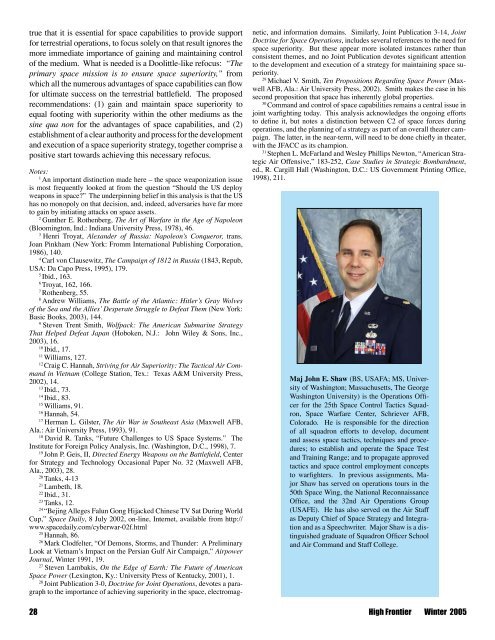Space Superiority
Space Superiority
Space Superiority
You also want an ePaper? Increase the reach of your titles
YUMPU automatically turns print PDFs into web optimized ePapers that Google loves.
true that it is essential for space capabilities to provide support<br />
for terrestrial operations, to focus solely on that result ignores the<br />
more immediate importance of gaining and maintaining control<br />
of the medium. What is needed is a Doolittle-like refocus: “The<br />
primary space mission is to ensure space superiority,” from<br />
which all the numerous advantages of space capabilities can flow<br />
for ultimate success on the terrestrial battlefield. The proposed<br />
recommendations: (1) gain and maintain space superiority to<br />
equal footing with superiority within the other mediums as the<br />
sine qua non for the advantages of space capabilities, and (2)<br />
establishment of a clear authority and process for the development<br />
and execution of a space superiority strategy, together comprise a<br />
positive start towards achieving this necessary refocus.<br />
Notes:<br />
1<br />
An important distinction made here – the space weaponization issue<br />
is most frequently looked at from the question “Should the US deploy<br />
weapons in space?” The underpinning belief in this analysis is that the US<br />
has no monopoly on that decision, and, indeed, adversaries have far more<br />
to gain by initiating attacks on space assets.<br />
2<br />
Gunther E. Rothenberg, The Art of Warfare in the Age of Napoleon<br />
(Bloomington, Ind.: Indiana University Press, 1978), 46.<br />
3<br />
Henri Troyat, Alexander of Russia: Napoleon’s Conqueror, trans.<br />
Joan Pinkham (New York: Fromm International Publishing Corporation,<br />
1986), 140.<br />
4<br />
Carl von Clausewitz, The Campaign of 1812 in Russia (1843, Repub,<br />
USA: Da Capo Press, 1995), 179.<br />
5<br />
Ibid., 163.<br />
6<br />
Troyat, 162, 166.<br />
7<br />
Rothenberg, 55.<br />
8<br />
Andrew Williams, The Battle of the Atlantic: Hitler’s Gray Wolves<br />
of the Sea and the Allies’ Desperate Struggle to Defeat Them (New York:<br />
Basic Books, 2003), 144.<br />
9<br />
Steven Trent Smith, Wolfpack: The American Submarine Strategy<br />
That Helped Defeat Japan (Hoboken, N.J.: John Wiley & Sons, Inc.,<br />
2003), 16.<br />
10<br />
Ibid., 17.<br />
11<br />
Williams, 127.<br />
12<br />
Craig C. Hannah, Striving for Air <strong>Superiority</strong>: The Tactical Air Command<br />
in Vietnam (College Station, Tex.: Texas A&M University Press,<br />
2002), 14.<br />
13<br />
Ibid., 73.<br />
14<br />
Ibid., 83.<br />
15<br />
Williams, 91.<br />
16<br />
Hannah, 54.<br />
17<br />
Herman L. Gilster, The Air War in Southeast Asia (Maxwell AFB,<br />
Ala.: Air University Press, 1993), 91.<br />
18<br />
David R. Tanks, “Future Challenges to US <strong>Space</strong> Systems.” The<br />
Institute for Foreign Policy Analysis, Inc. (Washington, D.C., 1998), 7.<br />
19<br />
John P. Geis, II, Directed Energy Weapons on the Battlefield, Center<br />
for Strategy and Technology Occasional Paper No. 32 (Maxwell AFB,<br />
Ala., 2003), 28.<br />
20<br />
Tanks, 4-13<br />
21<br />
Lambeth, 18.<br />
22<br />
Ibid., 31.<br />
23<br />
Tanks, 12.<br />
24<br />
“Bejing Alleges Falun Gong Hijacked Chinese TV Sat During World<br />
Cup,” <strong>Space</strong> Daily, 8 July 2002, on-line, Internet, available from http://<br />
www.spacedaily.com/cyberwar-02f.html<br />
25<br />
Hannah, 86.<br />
26<br />
Mark Clodfelter, “Of Demons, Storms, and Thunder: A Preliminary<br />
Look at Vietnam’s Impact on the Persian Gulf Air Campaign,” Airpower<br />
Journal, Winter 1991, 19.<br />
27<br />
Steven Lambakis, On the Edge of Earth: The Future of American<br />
<strong>Space</strong> Power (Lexington, Ky.: University Press of Kentucky, 2001), 1.<br />
28<br />
Joint Publication 3-0, Doctrine for Joint Operations, devotes a paragraph<br />
to the importance of achieving superiority in the space, electromagnetic,<br />
and information domains. Similarly, Joint Publication 3-14, Joint<br />
Doctrine for <strong>Space</strong> Operations, includes several references to the need for<br />
space superiority. But these appear more isolated instances rather than<br />
consistent themes, and no Joint Publication devotes significant attention<br />
to the development and execution of a strategy for maintaining space superiority.<br />
29<br />
Michael V. Smith, Ten Propositions Regarding <strong>Space</strong> Power (Maxwell<br />
AFB, Ala.: Air University Press, 2002). Smith makes the case in his<br />
second proposition that space has inherently global properties.<br />
30<br />
Command and control of space capabilities remains a central issue in<br />
joint warfighting today. This analysis acknowledges the ongoing efforts<br />
to define it, but notes a distinction between C2 of space forces during<br />
operations, and the planning of a strategy as part of an overall theater campaign.<br />
The latter, in the near-term, will need to be done chiefly in theater,<br />
with the JFACC as its champion.<br />
31<br />
Stephen L. McFarland and Wesley Phillips Newton, “American Strategic<br />
Air Offensive,” 183-252, Case Studies in Strategic Bombardment,<br />
ed., R. Cargill Hall (Washington, D.C.: US Government Printing Office,<br />
1998), 211.<br />
Maj John E. Shaw (BS, USAFA; MS, University<br />
of Washington; Massachusetts, The George<br />
Washington University) is the Operations Officer<br />
for the 25th <strong>Space</strong> Control Tactics Squadron,<br />
<strong>Space</strong> Warfare Center, Schriever AFB,<br />
Colorado. He is responsible for the direction<br />
of all squadron efforts to develop, document<br />
and assess space tactics, techniques and procedures;<br />
to establish and operate the <strong>Space</strong> Test<br />
and Training Range; and to propagate approved<br />
tactics and space control employment concepts<br />
to warfighters. In previous assignments, Major<br />
Shaw has served on operations tours in the<br />
50th <strong>Space</strong> Wing, the National Reconnaissance<br />
Office, and the 32nd Air Operations Group<br />
(USAFE). He has also served on the Air Staff<br />
as Deputy Chief of <strong>Space</strong> Strategy and Integration<br />
and as a Speechwriter. Major Shaw is a distinguished<br />
graduate of Squadron Officer School<br />
and Air Command and Staff College.<br />
28 High Frontier Winter 2005

















